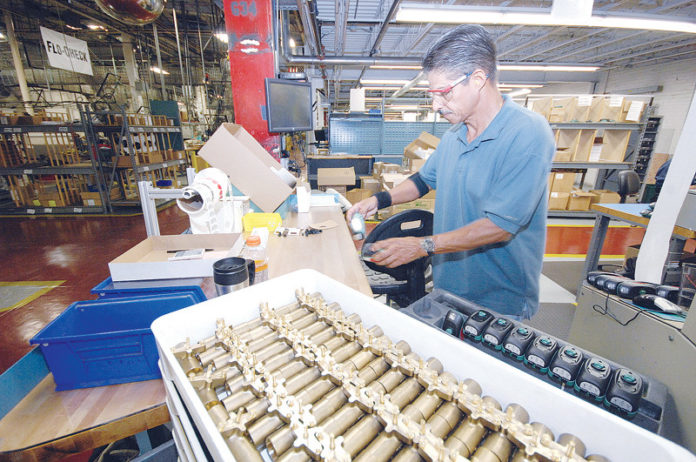
Big exports are possible in the smallest state.
At least that’s what business leaders believe, according to a recently released report from the Rhode Island Manufacturing Renaissance Project. The study, “Addressing Perceptions and Realities: The Rhode Island Manufacturing Renewal and Growth Program,” shows exports in the state have grown steadily since 2009.
The findings were released May 22 during World Trade Day at Bryant University in Smithfield.
The document provides insight into Rhode Island’s manufacturing landscape compared to the national environment and provides recommendations it says the state should pursue to grow manufacturing jobs. Among the top two priorities included in the report is the need to focus on manufacturing and grow exports. The report suggests focusing on export opportunities for U.S.-made products and services, which it considers among the fastest ways to grow manufacturing jobs in the country. According to numbers from the U.S. Department of Commerce, 48 percent of the country’s GDP growth in 2012 came from exports.
“Rhode Island manufacturers must recognize and take advantage of the opportunity,” said the report. “Rhode Island is the ideal location for exporters, with our three excellent port facilities and premier airport, modernized rail and highway infrastructure, and commitment to continuous improvement.”
Raymond W. Fogarty, executive director of the John H. Chafee Center for International Business at Bryant, said more than 1,000 Rhode Island manufacturers were polled as part of the survey. Among respondents, 70 percent of businesses are currently exporting and 36 percent that are not exporting plan to do so within one to two years.
Another 62 percent are interested in export-strategy planning.
“People have to recognize, ‘Hey, we can be productive here,’ ” said A. Ray Thomas, associate director of the Chafee Center for International Business.
The growth – and potential for more growth – is the result of many factors. The competitive American dollar, companies embracing automation and, equally as important, overcoming the fear of the unknown, are contributors.
But the goal is continued growth, said Thomas, and in part that’s where the Chafee Center for International Business comes in. Using information collected as part of the Rhode Island Manufacturing 1000 survey, manufacturers in the state will have access to a comprehensive database that will assist in gathering information about other businesses connecting across different business sectors.
“Once the company knows what to do, they can come to us and say, ‘I’m interested in having this kind of product, and we want to know where outside the United States we can export this,” said Fogarty. “So, we’ll put a team together, and we’ll research it for them.”
“One of the big things is what World Trade Day is all about: That’s training,” said Thomas. He said many companies could be slow to export or grow exports due to fear of the unknown. “They need to know how to go about it and where the opportunities are.”
He said the state needs to put more dollars in general investments for business development.
John Hazen White Jr., president of Taco Inc. in Cranston, said approximately 8 percent of his business is done overseas. Taco, which manufactures residential and commercial hydronic systems, hasn’t seen its export figures swing dramatically up or down in years, said White. “I think it’s disappointingly consistent,” he said.
“The problem that doesn’t seem to get addressed, because ‘exports’ are such a universally tossed around word, is that everybody has a different potential in terms of what it means,” said White.
White said the profitability of his exports is largely linked to the economy, and the need for the product, in other areas of the world.
“I don’t do anything in Europe because that market is so saturated with my kind of product it makes me tired just thinking about it,” he said. He said his strongest market is the Middle East, dating back to American influence in countries like Saudi Arabia and Kuwait over the last 50 years. “They are very partial to American products. So, it’s a focus market. The point of what I am saying is we all need to look at where we can export,” he said.
Depending on the economy in a given place, the export potential decreases, he said. “Most American companies over the last 40 years have said to themselves, ‘We don’t need to sell product internationally because our borders are so big the growth potential is here,’ ” he said. “In fact, that is just not the case. We are looking internationally.”
For many of Rhode Island’s smaller businesses, limited exports are a direct result of the inability to dedicate time and resources to identify target markets. “My competitors have sales forces well beyond what I have in those markets, but I do have to take the time” to focus on those markets, said White. •












